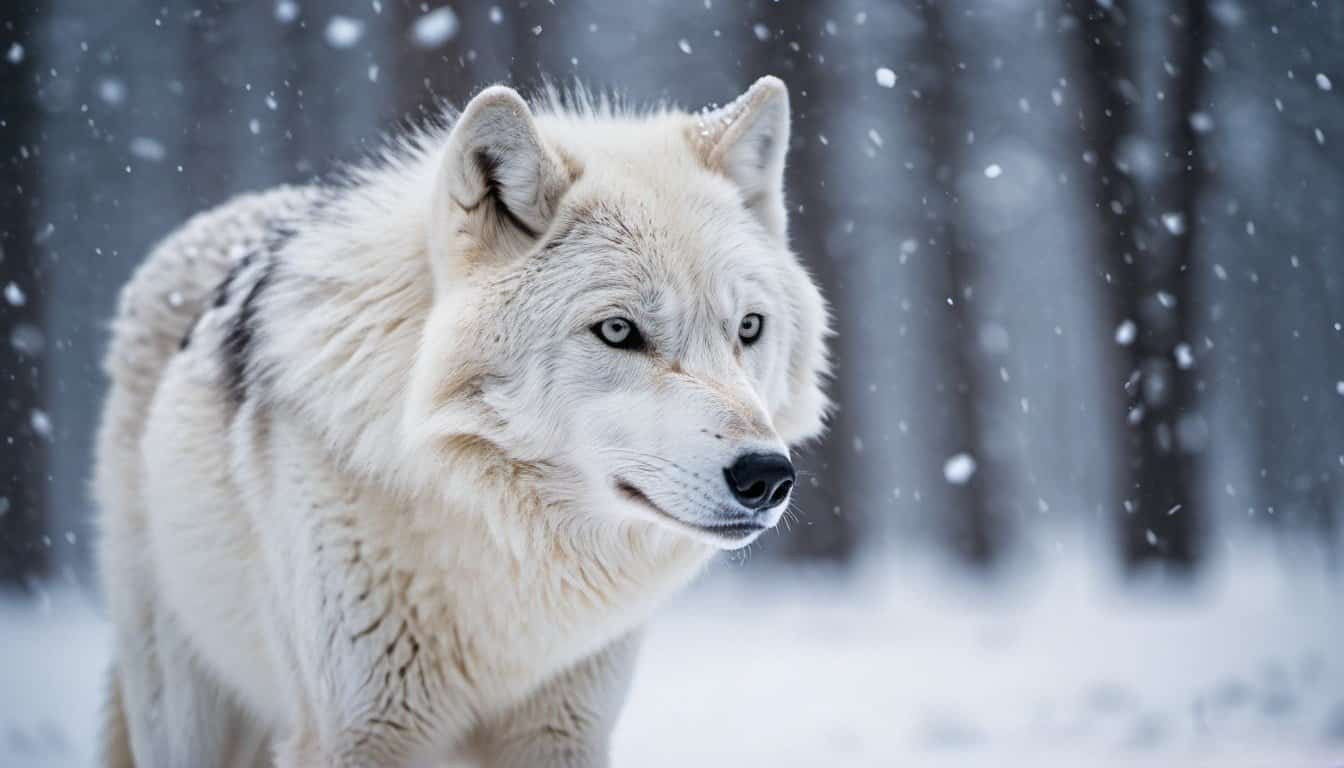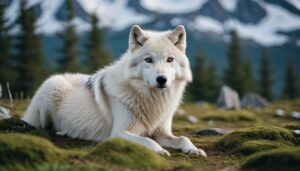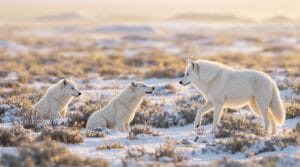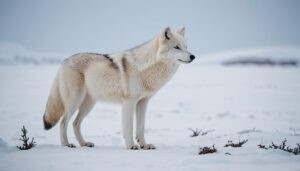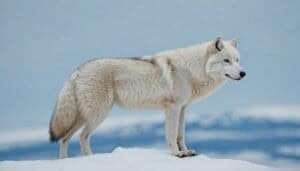Introduction
Arctic wolves, also known as white wolves, have developed remarkable behavioral adaptations to thrive in one of the planet’s harshest environments
This article explores how these resilient creatures find food, conserve heat, and use their surroundings to stay warm. We will also delve into their social dynamics, communication methods, and how they care for their young in freezing temperatures. Finally, we’ll examine how their behaviors change with the seasons
Behavioral Adaptations of Arctic Wolves to Extreme Cold
Arctic wolves have evolved various behaviors to survive the extreme cold of their environment. These adaptations are crucial for their survival and success in the harsh Arctic conditions
Finding Food in Extreme Cold
Arctic wolves face significant challenges in locating food in the barren, icy tundra. Their prey primarily includes muskoxen, Arctic hares, and caribou. Wolves utilize their keen sense of smell to detect prey buried under deep snow
They can smell animals from several miles away, which is vital in the vast Arctic landscape where food is scarce
During the winter, when food is even more limited, Arctic wolves will travel long distances, sometimes up to 30 miles in a day, in search of sustenance. They hunt in packs, which increases their efficiency and success rate. Wolves coordinate their attacks, often isolating a weak or young animal from the herd to bring it down
Hunting Strategies in the Arctic
Hunting in the Arctic requires specific strategies adapted to the environment. Arctic wolves hunt in packs, which provides several advantages:
Coordinated Efforts: Pack hunting allows wolves to strategize and execute complex hunting techniques. They can surround and isolate prey, making it easier to capture
Sharing Resources: After a successful hunt, the pack shares the kill, ensuring that each member receives the necessary nutrition to survive the harsh conditions
In addition to pack hunting, Arctic wolves utilize the landscape to their advantage. They often hunt near cliffs or steep terrain, where they can corner prey and prevent escape. Their white fur also provides camouflage against the snow, helping them approach unsuspecting animals more easily
Conserving Heat and Using the Environment
To survive the extreme cold, Arctic wolves have developed several behaviors and strategies to conserve heat and make use of their environment effectively
Conserving Heat
Arctic wolves have several behavioral adaptations to conserve heat:
Huddling Together: Wolves often sleep close to each other to share body heat. This huddling behavior is especially crucial during severe cold spells and helps maintain a stable body temperature
Curling Up: When resting, Arctic wolves curl into a ball, covering their nose with their tail. This position minimizes heat loss by reducing the surface area exposed to the cold
Reducing Activity: During extremely cold periods, wolves may reduce their activity levels to conserve energy and body heat. They will stay in sheltered areas and limit unnecessary movements
Using the Environment to Stay Warm
Arctic wolves utilize their environment to find shelter and stay warm:
Denning: Wolves dig dens in the ground, which provide protection from the wind and cold. These dens are often located in sheltered areas, such as the side of a hill or under thick vegetation, which helps insulate them from the harsh weather
Snow as Insulation: Wolves sometimes dig into the snow to create a makeshift shelter. Snow acts as an insulator, trapping heat and providing a warmer space compared to the open air
Seeking Natural Shelters: Wolves use natural formations, such as rock outcrops or dense vegetation, to shield themselves from wind and snow. These areas offer a break from the harsh elements and help conserve body heat
Sleeping Habits in Cold Conditions
Arctic wolves have specific sleeping habits to endure the freezing temperatures:
Choosing Sheltered Spots: Wolves select sleeping spots that offer maximum protection from the wind and cold. They often rest in areas with some form of natural cover, such as beneath trees or in depressions in the ground
Daytime Resting: Wolves tend to be more active during dawn and dusk, resting during the day when temperatures can be slightly warmer. This behavior reduces their exposure to the coldest parts of the night
Social and Pack Dynamics
The social structure and pack dynamics of Arctic wolves are critical for their survival in extreme cold environments. These social behaviors help them hunt efficiently, communicate effectively, and support each other during the harshest conditions
Social Behaviors for Cold Survival
Arctic wolves exhibit several social behaviors that aid in their survival:
Cooperative Hunting: Wolves hunt in packs, which allows them to take down larger prey and increases their hunting success. This cooperation is essential in an environment where food is scarce
Food Sharing: After a successful hunt, wolves share the kill with the pack. This ensures that all members, including the young and old, receive the necessary nutrients to survive
Caregiving: Pack members take care of each other, grooming and providing warmth during cold spells. This social bonding is crucial for maintaining pack cohesion and survival
Pack Dynamics in Extreme Cold
The structure of the wolf pack helps them endure the extreme cold:
Alpha Leadership: The alpha male and female lead the pack, making decisions about hunting, territory, and movement. Their leadership ensures that the pack remains organized and effective in their strategies
Pack Hierarchy: A well-defined hierarchy within the pack reduces conflicts and promotes cooperation. Each wolf knows its role, whether as a hunter, caregiver, or lookout
Protection and Defense: Pack members protect each other from threats, including rival packs and predators. They defend their territory and resources, ensuring the safety and well-being of the group
Communication in Harsh Environments
Effective communication is vital for Arctic wolves to coordinate their activities and maintain pack cohesion:
Vocalizations: Wolves use howls, barks, and whines to communicate over long distances. Howling helps pack members locate each other, especially in the vast, open Arctic landscape
Body Language: Wolves use body language to convey messages and maintain social order. Tail positions, ear orientations, and facial expressions communicate intentions and emotions
Scent Marking: Wolves mark their territory with scent to communicate their presence and boundaries to other packs. This reduces conflicts and helps maintain clear territorial boundaries
Caring for Young and Seasonal Changes
Arctic wolves demonstrate specific behaviors to care for their young and adapt to seasonal changes. These adaptations ensure the survival and development of the next generation in a challenging environment
Caring for Young in Freezing Temperatures
The survival of wolf pups in the Arctic requires significant effort and adaptation from the pack:
Denning for Birth: Pregnant females dig dens in sheltered areas, such as under rock overhangs or in thick vegetation, to give birth. These dens provide protection from the cold and predators
Parental Care: Both parents and other pack members participate in caring for the young. They provide warmth by huddling together and feeding the pups regurgitated food until they are old enough to eat solid prey
Extended Care: Unlike many other animals, wolves care for their young for an extended period. Pups stay with the pack for several months to learn essential survival skills, including hunting and social behaviors
Seasonal Behavioral Changes
Arctic wolves adjust their behaviors with the changing seasons to optimize their survival:
Winter Adaptations: During the harsh winter months, wolves increase their reliance on pack cooperation for hunting and warmth. They conserve energy by reducing activity and seeking shelter during the coldest parts of the day
Summer Adaptations: In the brief Arctic summer, wolves take advantage of the abundance of prey. They are more active, hunting frequently to build up fat reserves for the upcoming winter. Pups are born in spring or early summer, allowing them to grow during the milder months
Migration and Movement: Some Arctic wolf packs exhibit migratory behavior, following the movements of their prey, such as caribou. This seasonal migration ensures a consistent food supply throughout the year
Conclusion
Arctic wolves have evolved a complex set of behavioral adaptations to survive the extreme cold of their environment. From cooperative hunting and heat conservation strategies to effective communication and caring for their young, these behaviors are essential for their survival
The pack dynamics, social structures, and seasonal adjustments ensure that Arctic wolves can endure the harsh conditions and continue to thrive in one of the most challenging habitats on Earth
